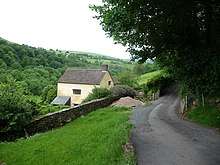Ty-mawr Farmhouse, Cwmyoy
Ty-mawr Farmhouse, Ffwthog, Cwmyoy, Monmouthshire is a farmhouse dating from the early 16th century, which was extended in the 17th century and then reduced in size in the 18th century. The farmhouse is a Grade II* listed building, with its range of barns and its bee shelter having separate Grade II listed building designations.
| Ty-mawr Farmhouse, Ffwthog, Cwmyoy | |
|---|---|
 "a well-preserved 17th century house" | |
| Type | House |
| Location | Cwmyoy, Monmouthshire |
| Coordinates | 51.9031°N 3.0424°W |
| Built | early 16th century and later |
| Architectural style(s) | Vernacular |
| Governing body | Privately owned |
Listed Building – Grade II* | |
| Official name: Ty-mawr Farmhouse | |
| Designated | 11 April 1996 |
| Reference no. | 18111 |
Listed Building – Grade II | |
| Official name: Barn Range at Ty-Mawr | |
| Designated | 11 April 1996 |
| Reference no. | 18112 |
Listed Building – Grade II | |
| Official name: Bee bole at Ty-mawr Farm | |
| Designated | 29 January 1998 |
| Reference no. | 19256 |
 Location of Ty-mawr Farmhouse, Ffwthog, Cwmyoy in Monmouthshire | |
History
The original farmhouse dates from the early 16th century.[1] In the 17th century, the house was extended and a new range constructed to a traditional H-plan.[2] In the 18th century, the building was reduced in size, particularly impacting on the original 16th century building,[1] of which little remains but the two-storey porch,[2] which formed the dairy to the 18th century house.[1] The farmhouse remains a private residence and the architectural historian John Newman remarks on a "careful restoration" dating from 1995 to 1996.[2]
Architecture and description
Cadw records that the farmhouse is of two storeys with attics.[1] The building is of stone, which has been rendered, under a stone tile roof.[1] The interior shows evidence that the farmhouse may have housed two separate households in the 17th century.[2] The farmhouse is listed Grade II*.[1] Adjacent to the house is the "impressive" seven-bay barn dating from the 17th century,[2] which has its own Grade II listing.[3] There is also a Grade II listed bee-shelter,[4] which may date from the 19th century or may be earlier.[4] In 2013 the bee-shelter was on the Brecon Beacons National Park Buildings at risk register.[5]
Notes
- "Listed Buildings - Full Report - HeritageBill Cadw Assets - Reports". Cadwpublic-api.azurewebsites.net. 1998-01-29. Retrieved 2017-08-25.
- Newman 2000, p. 228.
- "Listed Buildings - Full Report - HeritageBill Cadw Assets - Reports". Cadwpublic-api.azurewebsites.net. 1998-01-29. Retrieved 2017-08-25.
- "Listed Buildings - Full Report - HeritageBill Cadw Assets - Reports". Cadwpublic-api.azurewebsites.net. 1998-01-29. Retrieved 2017-08-25.
- "Buildings at Risk Register 2013" (PDF). Brecon Beacons National Park Authority. 2 July 2014. Retrieved 2017-08-26.
References
- Newman, John (2000). Gwent/Monmouthshire. The Buildings of Wales. London: Penguin. ISBN 0-14-071053-1.